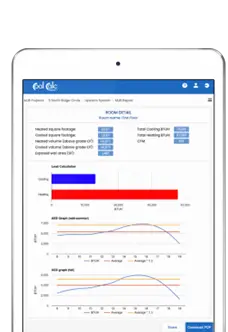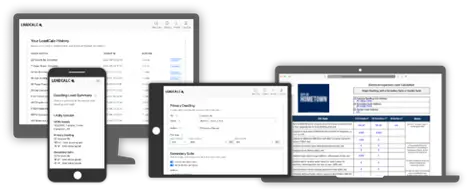The advent of modern technology has transformed the world we live in. What seemed like an impossible task only a few years ago, can now be completed within minutes. All you need to do is click a few buttons on your computer or smartphone. This is no different for HVAC load calculation either.
The heating, ventilation, and cooling (HVAC) systems, when installed in a house, clean the air and improve its quality. Also, it provides warm or cool air depending on the climate’s needs.
Many people planning to get an HVAC system assume that they are simply installing a new one or replacing an older HVAC system. Well, that is not the case. You can’t pick a random HVAC system and install it in your house. If done, it will refrain from giving a good performance and energy efficiency and lasts only for a short time.
To choose the ideal HVAC system, HVAC load calculations must be done, and if it is done manually, it consumes immense effort and time. This is where the HVAC load calculation software steps in.
First, understand that the HVAC load calculation is a mathematical process that considers multiple aspects of a house to determine the best size, application, and style of the HVAC industry. This calculation ensures maximum energy efficiency while enhancing the home’s comfort.
Those days, load calculations were done manually. But with technological advancements, HVAC technicians can quickly calculate the heating and cooling loads using robust ac load calculation software. The HVAC load software or calculator determines how much heating and cooling a residential building needs, based on its HVAC design and specifications.
HVAC load calculations consider several specific areas in your house to find the right-sized system:
- Total square footage of the property
- Number of windows, doors, and entryways
- Number of floors & living space
- What exact landscaping outside your house can block the sun from entering the house?
- The duct work condition, size of ductwork, and the vent systems
- Window shades, blinds, or other household window treatments used to keep the sun out
US Energy Information Administration (EIA) shows that heating and cooling systems are the largest residential electricity uses. If the right size equipment is not installed, it may easily reflect on energy bills. So it is crucial to calculate the load properly before installing the HVAC systems. Otherwise, your customers will end up shedding cash for a larger or smaller unit than necessary and face issues over time. As a result, it will affect your company’s customer satisfaction level and in turn, bring down your customer retention rate and profitability. Therefore, it is crucial that you do your heating and cooling load calculation right.
If you are an HVAC business owner looking for the best HVAC Load Calculation tool, this article will answer all your queries. We have listed the five best HVAC calculator software. Without further ado, let’s check them out.
Table of Contents
- 1. HeatCAD
- 2. Area Cooling Solutions
- 3. CoolCalc
- 4. LoadCalc
- 5. EDS HVAC
- HeatCAD
HeatCAD is a drawing-based software that delivers fast and accurate cooling and heating load calculations for residential heating and cooling loads.
This robust HeatCAD HVAC load calculation software comes in two editions: Professional Edition and MJ8.
The Professional Edition of HeatCAD supports ASHRAE and CSA residential heat loss calculations. Meanwhile, the MJ8 edition supports ACCA Approved Manual J calculations for residential cooling and heating loads.
Apart from delivering HVAC load calculations, this software gives advanced design features, including integrated load calculation HVAC, 3D CAD views, and automatic detection of unheated surfaces.
- Area Cooling Solutions
Area Cooling Solutions, an HVAC and refrigeration company, consistently provides smart solutions for a green future. With over 10 years of experience in inverter driver applications, remote control, and preventive maintenance, this company also offers a robust heating and cooling load calculator.
This HVAC load calculation software allows you to select their products based on your needs. You can quickly choose your ideal equipment from compressors or condensing units based on the capacity or a specific product line. So this simplifies the selection process and helps you find your exact need.
- CoolCalc
CoolCalc is a simple yet effective software to calculate manual J of any given space. This ACCA approved HVAC load calculator, has been stuffed with many new features in its recent update. The version 3.0 has extended its functionalities with third-party plugins like LennoxPros and Google Maps to enhance the user experience.
CoolCalc is so simple, even a user with less or no experience could calculate Manual J easily. It is designed keeping in mind its usage in a mobile phone along with other devices. You can access this software from your mobile phones seamlessly. It works well on other devices as well.
CoolCalc also comes with a full API so you can integrate other websites or applications with it easily. CoolCalc provides a fully functional software development kit (SDK) with an entire framework to customize your style.
- LoadCalc
LoadCalc is an HVAC load calculator software designed based on Manual J calculation. Since the LoadCalc HVAC load calculator uses Manual J calculation, you can get a decent estimate. This easy and quick load calculation software calculates the amount of heating and cooling British Thermal Unit for the whole house or room by room load.
- EDS HVAC
Energy Design Systems (EDS), an HVAC software company, delivers two amazing tools: the HVAC load calculator and the Home Auditor.
The EDS load calculator is among the easiest and the most accurate residential heat loss and heat gain load calculators in the market. This software helps find the best size, application, and type of HVAC system for a house in under five minutes. This is done by utilizing the data from Zillow, Google Earth, and other real estate databases combined with a complex series of algorithms and equations.
With this HVAC load calculator, you can get accurate heat load calculation. Thus, you can minimize operating and equipment costs, enhance equipment longevity and improve the health and comfort of your house by installing the right equipment.
So, what are you waiting for? Choose the right digital tool for your HVAC business.












